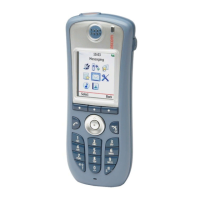TD 92685EN
28 June 2012 / Ver. A
Troubleshooting Guide
Ascom i62 VoWiFi Handset
19
3. The VoWiFi Handset as
deemed sufficient for ensuring the handset is able to support adequate voice quality
between APs:
RSSI Scans Roams
> -73dBm Every 5secs. If a candidate AP offers an improvement of
6dBm or more
<
-73dBm Every 5secs. If a candidate AP offers an improvement of
3dBm or more
Additio
nal Scan in Call Mode
An additional scan is triggered in call mod
e wh
en a reduction of >= 6dBm is detected in a
beacon being sent by the AP at the regular beacon interval.
3.6.3 System-Aided Roaming
When the handset operates in a WLAN where the sys
t
em is responsible for roaming, use the
PDM to set the handset to system aided roaming. From the menu Network, select the active
network (A, B, C or D) and then select the parameter Roaming methodology. Set the value to
“System-aided roaming”. The handset will then only perform a scan when the RSSI drops
below -70dBm both in call and in idle mode.
3.7 DFS Channel Probing
The 5 GHz band supports a minimum of 21 non-overlapping channels and potentially a few
more depending on different regulatory domains. The following table, for example, shows
the channels supported in the ETSI regulatory domain:
Band Channel
UNII-1 36, 40, 44, 48
UNII-2 52, 56, 60, 64
UNII-2e 100, 104, 108, 112, 116, 132, 136, 140
UNII-3 149, 153, 157, 161
ISM 165
The radio channels in the UNII-2 and UNII-2e ban
ds are DFS-chan
nels, which may be used by
civilian and military radar such as aviation and weather radar. Because radar always has a
higher priority than a WLAN, additional procedures must be employed to prevent LAN
devices from interfering with radar when the radar is using the DFS channels. This can
increase latency and degrade the performance in a WLAN.
A client that does not support radar detection is not allowed
to actively
scan for APs in the
DFS channels. The client is only allowed to perform passive scanning, which means that it
can only listen for beacons. For a voice client, this will affect an ongoing call to some degree
by introducing a slight increase in jitter in the voice stream.
The handset can use the Dynamic Frequency Select
ion (DFS) channels in a voice enabled
WLAN, but the voice quality can be distorted as the DFS channels must be treated
differently in the scanning process.
The probing process above is repeated each time th
e handset needs to find roaming
candidates, that means, when the signal quality on its current associated AP decreases.
Another reason that the use of DFS
channels is not recommended in areas where radar may
be operating, is the requirement of automatic switching of channels and the non-service
time gap that occurs. Note that radar can be airborne, for example, used by aircraft for
navigational purposes.

